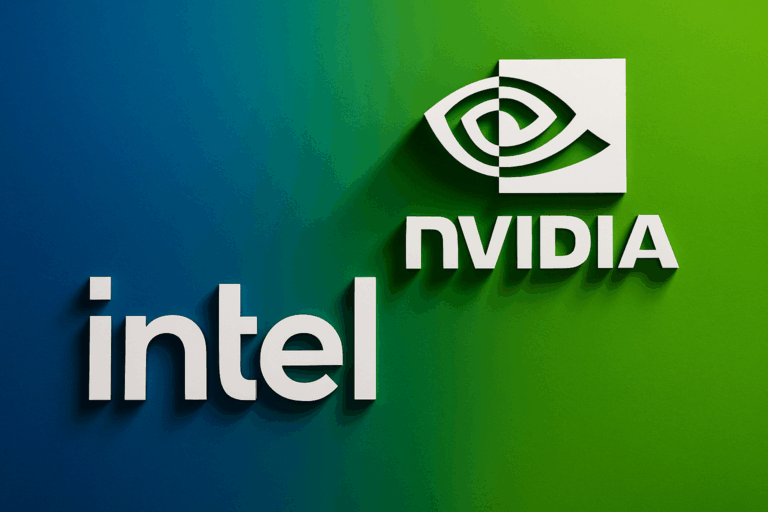Last week, Nvidia announced it would heavily invest in Intel to become a major shareholder in the ailing company. More remarkably, the two chip giants will partner up to deliver co-engineered PCs and data center products. Dramatic shifts are on the way both inside Intel itself and within the chip industry at large, as ‘Chipzilla’ no longer stands alone in its battle for survival.
Intel is selling 17 percent of itself for 5 billion dollar, having already sold 10 percent to the U.S. government for 8.9 billion dollar. Together, the investments represent far more than the cash value: they bolster Intel’s ability to compete in markets it is struggling in and delineate where the company’s potential futures lie. For example, the Trump administration’s investment requires Intel to retain at least 51 percent of its foundry business. AMD needed no such commitment when it spun off GlobalFoundries in 2009, meaning it significantly reduced its overhead and became a light-footed company. Had it not done so back then, AMD’s revival under Lisa Su may not have been possible.
Nevertheless, the road travelled by Intel is distinct. We’ve been told repeatedly just how close the link between Intel the chip designer and Intel the foundry is (very, by all accounts). This means Intel needs to cut its losses elsewhere, leading to the Nvidia deal we saw last week. Rather than trying to compete with the AI giant, Intel is joining it. Future products destined for client as well as data center devices will feature Intel+Nvidia combos, likely designed to amplify the benefits of x86 as well as CUDA, the software stack upon which Nvidia has built its empire.
A strong duo
As dominant as Nvidia is in terms of AI infrastructure, its customers (especially the few big ones that truly matter to Nvidia’s bottom line) are just about as eager to diversify. The monolithic Nvidia-laden “AI factories” that represent the core of the company’s business are being built as we speak, but simultaneously, plans are drafted to replace the need for them in the first place. AWS, Google Cloud, OpenAI and now Microsoft have either built or are building AI chips that reduce the need for Nvidia, meaning the moat the latter has built is contested.
Intel’s scenario is more complex than Nvidia’s, at least in the data centre space. Whereas Intel’s revenue from selling Xeon chips has trended lower than AMD’s Epyc gains, the former’s market share remains relatively stable. The great benefit from being only one of two meaningful x86 license holders is that there is little choice by design. Arm in the data centre isn’t replacing x86, but a mere addition. In this far more stable market of data centres of all shapes and sizes, an Intel-Nvidia combo may well be the right mix of x86 familiarity and AI horsepower to turn even the humblest colocations into tiny AI factories.
On the client side, Intel may well make further tough choices. Gutting Arc, Intel’s fledgling GPU project, would leave no road back to competing with Nvidia. Attention would instead go to CPU architecture only, limiting the reach of the Intel domain. AMD still holds both CPU and GPU cards, with the revenue to boot. Hyperscalers have reportedly relied on AMD’s Instinct GPUs to act as an internal challenger to Nvidia hardware. With the Intel-Nvidia deal, such initiatives may become less attractive. AMD may wish to partner with another chip player to foster growth on its GPU side; would Qualcomm be an option? That’s what former Intel director Ryan Shrout suggests, at any rate.
NVLink needs help
Nvidia aims to widen the reach of NVLink through NVLink Fusion, an interconnect technology to radically accelerate the communication between chips. Intel follows Marvell Technology and MediaTek in adopting it. However, rather than being just an Nvidia partner (like just about any tech company is these days), Intel now has a vested interest in making NVLink as viable as it can be. Ethernet remains the favored technology among all but the most specialized and large-scale AI build-outs. It’s more flexible than NVLink despite bandwidth and latency downsides. A push from Intel to deliver co-engineered, co-packaged solutions with Nvidia would perhaps be enough to make a more meaningful dent here.
This all depends on what exactly Intel is planning to do with its newfound partners. If it goes all the way with Nvidia, this could result in the latter finding a TSMC alternative in Intel and also designing chips that integrate both CPU and GPU in a single package. This would tie Nvidia and Intel at the hip, and is therefore something that neither party would do in short order. Instead, Intel has secured its survival in the short to medium term. It now has to decide its long term future, if indeed that hasn’t already been determined for it by its new shareholders.
Also read: Nvidia invests $5 billion in Intel for joint chips
